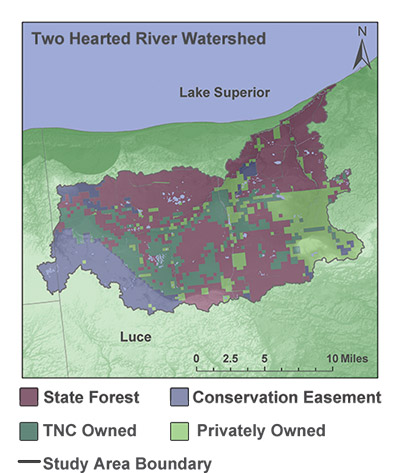Project Area

The Two Hearted River watershed, of Hemingway fame, lies in the eastern portion of Michigan's Upper Peninsula. It encompasses 53,653 ha of upland hardwood forests, pine stands, and coniferous forests, interspersed with a variety of wetland systems, including muskeg, bogs, and swamps. In recent decades, climate in the Upper Peninsula has become both warmer and wetter, with a pronounced decrease in summer precipitation (Motew and Kucharik 2013), and these trends are projected to continue throughout the century (Center for Climatic Research, University of Wisconsin - Madison 2013). Such changes in climate and seasonal patterns could influence the species composition and dynamics in northern temperate forests, as well as their management and ability to provide ecosystem services. Visit our Climate Change page for a more in-depth look at recent and projected climate change in the Upper Peninsula.
The Upper Peninsula has a long history of human habitation and use, with commercial use of the Upper Peninsula's natural resources beginning in the 1830's and 1840's with iron and copper mining in the western portion and logging in the east. Timber production remains a key ecosystem service provided by this landscape and a staple of the region's economy. At the same time, the watershed plays hosts to a great diversity of plant and animal species and a destination for outdoor recreation.
The current ownership and conservation in the watershed are a result of the Northern Great Lakes Forest Project, or the "Big U.P. Deal" as it became known informally - an initiative by The Nature Conservancy that began in 2001. Today, the Michigan Department of Natural Resources (DNR), the Forestland Group (a timber investment management organization, or TIMO), and the Conservancy together own 80% of the THR watershed. The remaining 20% is held in private ownerships. All of the land controlled by the TIMO is managed under working forest conservation easements held by the DNR. These diverse owners have multiple management objectives, ranging from a focus on conservation of biodiversity (the Conservancy), improvement of forest condition for investors (TIMOs), and recreation, forest products, and reduction of fire risk (DNR). This area exemplifies the complex mosaic of ownership, management, and conservation challenges typical of broad-scale conservation efforts in the U.S. today.